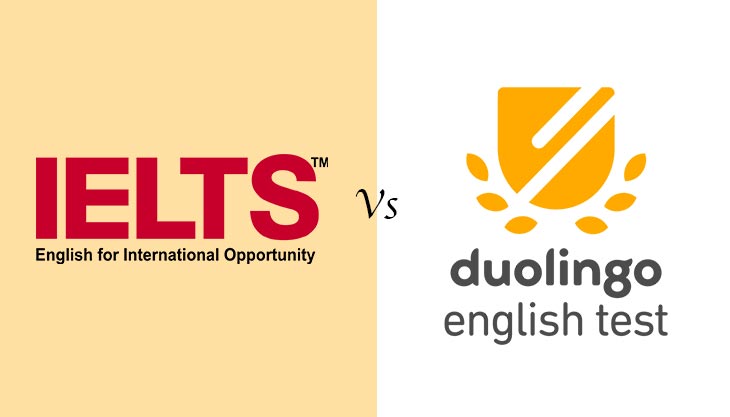The Language Showdown: Duolingo vs IELTS
Embarking on a journey to study, work, or live in an English- speaking environment often requires proving your language proficiency. Two popular contenders in this arena are DUOLINGO and IELTS.
Given that many universities accept multiple exam scores, choosing between IELTS and Duolingo can be confusing. To make an informed decision, test takers should carefully weigh the characteristics and benefits of each option, taking into account their personal preferences, institutional needs, and the specific aims associated with the English proficiency assessment.
In this blog, we'll explore the differences between these two tests, so you can make an informed decision about which one aligns better with your needs and aspirations.
What is Duolingo?
The Duolingo English Test (DET) is one of the most accessible and renowned language proficiency assessments in the world. Its convenience, cost-effectiveness, and quick turnaround periods have made it a popular alternative for students, professionals, and others who want to demonstrate their English language skills.
The test is entirely online and consists of multiple-choice questions including Reading, Writing, Listening, and Speaking.
Structure and format of Duolingo’s Language proficiency test
| Sections | Time Period |
|---|---|
| Adaptive Examination (Reading, Listening, Writing, and Speaking) | 45 minutes |
| Video Interview | 10 minutes |
The adaptive graded section, lasting 45 minutes, encompasses diverse question types base on reading, writing, listening, and speaking skills.
Duolingo is divided into two parts:
Listening
This section measures the candidate's ability to understand spoken English by asking questions based on a conversation between people or completing sentences based on a listening passage.
Reading
In this part, the candidate must read a passage and answer questions about it
Writing
In this stage, candidates may have to describe an image or complete a text by filling in the blanks.
Speaking
This segment tests test takers' spoken English by asking them to describe an image or speak about a certain topic
Learners may take as many Duolingo tests as they like. However, the exam can only be administered twice in a 30-day period. Furthermore, the candidate may only reapply after the result of the last attempt becomes available.
Score interpretation of Duolingo
The score range for the Duolingo English test is 10 to 160.
10-55 Capable of understanding basic English words and phrases, as well as communicating in familiar circumstances.
60-95 A candidate should be able to understand ordinary life issues such as speaking on common topics, discussing their beliefs, plans, and experiences during a speaking interview.
100-125 Can communicate fluently and understand concepts from unexpected themes, engage easily with skilled speakers, and comprehend the essential concepts of both physical and abstract writing.
130-160 Able to understand complex written and spoken language, including specialized vocabulary, metaphorical expressions, idioms, and implicit language. Adapts language effectively for professional, academic, and social purposes
What is IELTS ?
IELTS, or the International English Language Testing System, is a standardized test which is designed to assess the language proficiency of individuals who want to study, work, or migrate to English-speaking countries. It evaluates Listening, reading, writing, and speaking skills and is widely recognized by universities, employers, and immigration authorities globally.
Structure and format of IELTS Language proficiency test
The IELTS is divided into four sections, assessing different language skills. Here’s a brief overview of the structure and format:
Listening (30 minutes):
- Four recorded audio passages, including conversations and monologues.
- 40 questions in total, evaluating your ability to locate information, identify main ideas, and understand detailed opinions.
Reading (60 minutes):
- Three sections with a variety of text types(e.g., articles, advertisements, extracts from books).
- 40 questions in total, evaluating your ability to locate information, identify main ideas, and understand detailed opinions.
Writing (60 minutes):
- Task 1: A short report (150 words) based on visual information, such as a graph or chart.
- Task 2: An essay (250 words) expressing your opinion on a given topic.
Speaking (11-14 minutes):
- Part-1: Introduction and interview about familiar topic (e.g., hobbies, family).
- Part-2: You receive a task card with a topic and have one minute to prepare before speaking for two minutes.
- Part-3: A discussion related to the Part 2 topic, exploring more abstract ideas and issues.
The IELTS test is crafted to evaluate one’s proficiency in effective English communication, encompassing a spectrum of skills spanning listening and reading to writing and speaking. To excel in the test, it is imperative for individuals to acquaint themselves with the format and diligently practice each section.
SCORE INTERPRETATION OF IELTS SCORES
Here’s a general interpretation of IELTS scores:
1. BAND-9 (Expert user): A very level of English proficiency. The test- taker has full command of the language, understanding and using it effectively in all situations.
2. BAND-8 (Very good user): A very good command of English. The test-taker has a wide range of vocabulary and can use language flexibly and effectively.
3. BAND-7 (Good user): A good user of English. The test-taker has operational command of the language, with occasional inaccuracies and misunderstandings in some situations.
4. BAND-6 (Competent user):A competent user of English. The test-taker generally understands and uses complex language well, but there can be some mistakes and misunderstanding in unfamiliar situations.
5. BAND-5 (Modest user): A modest user of English. The test-taker has partial command of the language, coping with overall meaning in most situations but is likely to make many mistakes.
6. BAND-4 (Limited user): A limited user of English. The test-taker is able to convey and understand only general meaning in familiar situations.
7. BAND-3 (Extremely Limited User): The test-taker conveys and understands only general meaning in very familiar situations. There are frequent breakdowns in communication.
8. BAND-2 (Intermittent user): The test-taker has great difficult understanding spoken and written English.
9. BAND-1(Non-user): The test-taker has no ability to use the language except for a few isolated words.
10. BAND 0 (Did Not Attempt the Test): The test-taker did not answer the questions.
Test-takers should be aware that various institutions or employers may have specific IELTS score requirements. It is Crucial for individuals to verify the score prerequisites of the particular institution or employer they are applying to. Additionally, IELTS scores remain valid for a period of two years.
CONCLUSION
This blog tries to compare scores from the Duolingo English Test to those of IELTS, shedding light on the correlation and distinctions between these assessments. To explore this comparative analysis, an individual can make informed decisions about the most suitable language proficiency test for their academic pursuits.
COMPARISION BETWEEN IELTS AND DUOLINGO
| DETAILS | IELTS | DUOLINGO |
|---|---|---|
| Conducting Body | British Council and IDP IELTS. | Duolingo |
| Exam Fees (USD) | Ranges between $245 – USD 255 (INR 18186 – INR 18928) | $49 (INR 3600) |
| Duration of Exam | 165 mins | 60 mins |
| Sections | Reading, Writing, Listening and speaking | AdaptiveSection (Reading, Writing, Listening, and Speaking) |
| Result Declaration | 3-5 days ( Online Mode) and 13 days ( offline Mode) | 48 hours |
| Scoring Range | Bands (0-9) | Score (10-160) |
Frequently Asked Questions
Ques-1 How can I prepare for these tests?
A· Both IELTS and Duolingo offer official practice materials on their respective websites. Consider using these resources and explore additional study material to familiarize yourself with the test formats.
Ques-2 Which test is better for evaluating speaking skills?
A· IELTS includes a face-to-face speaking component, providing a more interactive assessment of speaking skills. Duolingo assesses speaking through an AI- powered interview.
Ques-3 Can I switch from one test to the other if needed?
A· It depends on the policies of the university you are applying to. Some institutions may allow flexibility, while others may have specific requirements. Always check with the university’s admission office for guidance.
Ques-4 How long are the test results valid?
A· The validity period of IELTS scores is typically two years valid. For the Duolingo English Test, the validity period may vary by institution, so it’s essential to check with the specific university.
Ques-5 Is there a significant cost difference between IELTS and Duolingo?
A· Duolingo’s test may be cost-effective for some, as it eliminates the need for travel to a testing center. However, costs can vary, and financial considerations may depend on individual circumstances.







